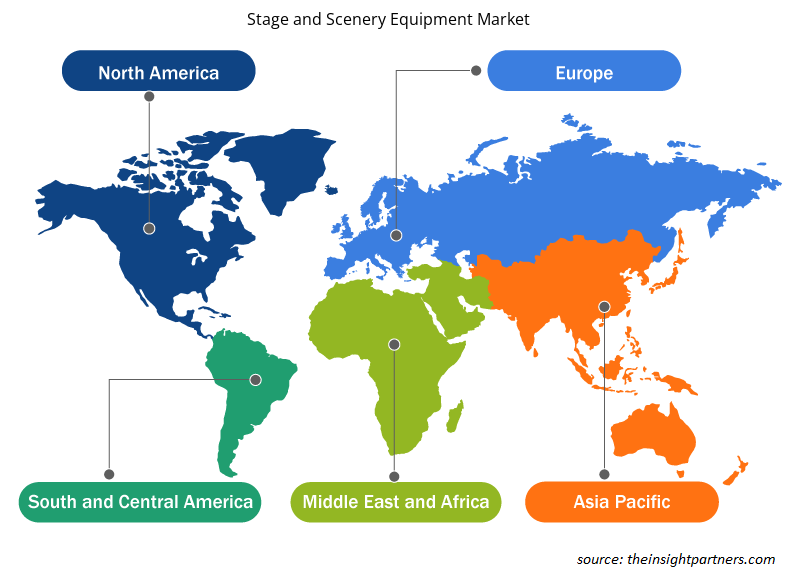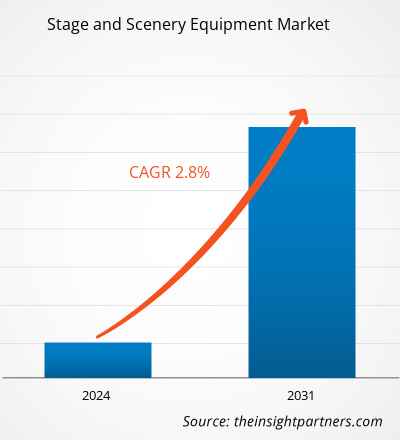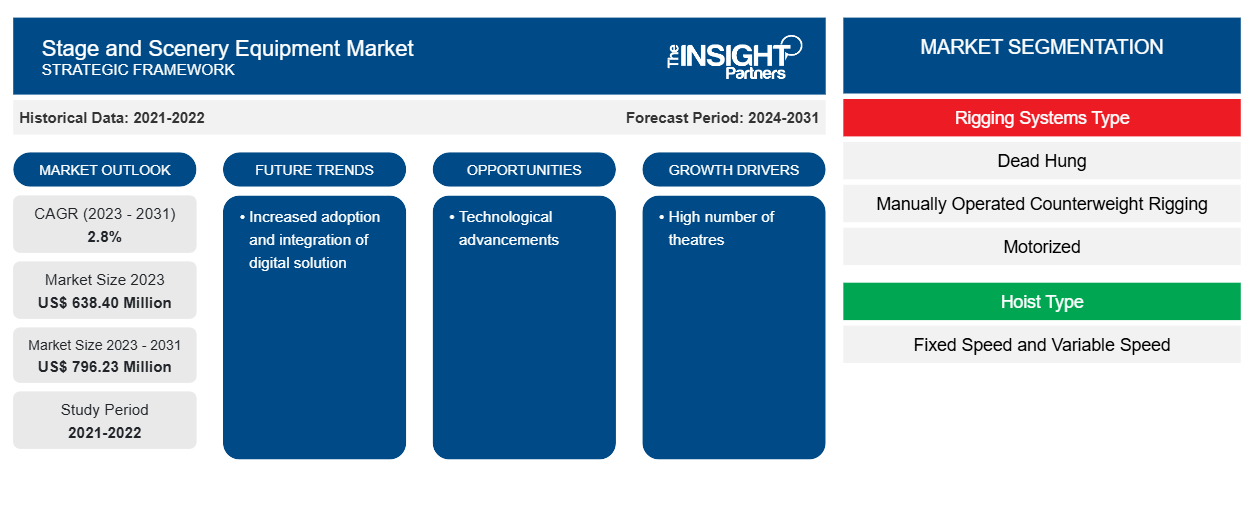La taille du marché des équipements de scène et de décor devrait atteindre 796,23 millions USD d’ici 2031, contre 638,40 millions USD en 2023. Le marché devrait enregistrer un TCAC de 2,8 % en 2023-2031. L’adoption accrue de solutions numériques et innovantes par les principaux acteurs de l’industrie fait partie des tendances récentes du marché des équipements de scène et de décor. Par exemple, WIcreations BVBA a présenté sa technologie de scène automatisée qui permet au manutentionnaire de contrôler à distance le palan, les ascenseurs et les treuils, entre autres.CAGR of 2.8% in 2023–2031. Increased adoption of digital and innovative solutions by the key players in the industry are some of the recent trends in the stage and scenery equipment market. For instance, WIcreations BVBA introduced its automated stage technology that enables the handler to remotely control the hoist,
Analyse du marché des équipements de scène et de décor
L’augmentation des dépenses en matière de divertissement est l’un des facteurs moteurs notables de l’industrie des équipements de scène et de décor. Selon l’étude réalisée par l’American Automobile Association en 2024, environ 37 % et 39 % des voyageurs de la génération Z et de la génération Y ont dépensé environ 500 à 5 000 dollars américains pour des événements en direct organisés dans des lieux distincts. De plus, selon les données publiées par Live Nation Entertainment, une société de billetterie réputée, les revenus annuels en 2023 ont connu une croissance de 36 %. De plus, selon l’entreprise, 2023 a été l’année la plus importante jamais enregistrée par rapport aux années précédentes, Ticketmaster ayant vendu environ 620 millions de billets. Cette croissance montre une augmentation des dépenses dans l’industrie du divertissement et un nombre croissant de concerts et de cinémas, entre autres. Un nombre croissant de ces modes de divertissement stimule directement la croissance de la demande d’équipements de scène et de décor.
Aperçu du marché des équipements de scène et de décor
L'Amérique du Nord est l'une des régions les plus importantes du marché mondial des équipements de scène et de décor. L'un des principaux facteurs à l'origine de la croissance du marché est le nombre élevé de clubs ; les salles de bal sont nombreuses aux États-Unis. Les États-Unis sont l'un des principaux pays comptant le plus grand nombre de discothèques de premier plan en 2023. Selon les données disponibles dans le domaine public, il existe environ plus de 60 000 discothèques aux États-Unis. Ainsi, avec un nombre aussi élevé de lieux de divertissement en Amérique du Nord, la demande d'équipements de scène et de décor est élevée. Cependant, le taux de croissance des équipements de scène et de décor dans la région nord-américaine devrait diminuer au cours de la période de prévision.
Personnalisez ce rapport en fonction de vos besoins
Vous bénéficierez d'une personnalisation gratuite de n'importe quel rapport, y compris de certaines parties de ce rapport, d'une analyse au niveau des pays, d'un pack de données Excel, ainsi que de superbes offres et réductions pour les start-ups et les universités.
-
Obtenez les principales tendances clés du marché de ce rapport.Cet échantillon GRATUIT comprendra une analyse de données, allant des tendances du marché aux estimations et prévisions.
Moteurs et opportunités du marché des équipements de scène et de décor
Le nombre élevé de théâtrestheatres
À mesure que le revenu disponible du consommateur a augmenté en raison de l'industrialisation et de l'urbanisation, les dépenses consacrées à l'industrie du divertissement ont considérablement augmenté. Par conséquent, en raison de l'augmentation des dépenses, le nombre de cinémas et d'autres lieux de divertissement a considérablement augmenté. Selon les données disponibles dans le domaine public, il y avait environ plus de 5 000 cinémas aux États-Unis seulement. En outre, dans de nombreuses économies en développement, le nombre de cinémas a augmenté rapidement. Selon les données, les cinémas en Inde ont connu une croissance d'environ 6 % en 2023 par rapport à 2022.theatres and other entertainment places increased notably. As per the data available in the public domain, there were approximately more than 5000 theatres in the US alone. In addition, in many developing economies the number of theatres increased rapidly. As per the data the movie theatres in India witnessed growth of approximately 6% in 2023 from 2022.
Progrès technologiques
À mesure que la technologie progresse, les consommateurs recherchent des expériences immersives et interactives. Ainsi, les fabricants du secteur développent des solutions innovantes pour offrir des expériences uniques à leurs consommateurs. L'intégration des systèmes de gréement avec la technologie interactive augmente considérablement. Ce système permet, entre autres, un éclairage réactif et un mouvement interactif des écrans. De tels systèmes d'intégration devraient générer des opportunités lucratives pour le marché des équipements de scène et de décor dans les années à venir.
Analyse de segmentation du rapport sur le marché des équipements de scène et de décor
Les segments clés qui ont contribué à la dérivation de l’analyse du marché des équipements de scène et de décor sont le type, la cause, le type de trouble, la catégorie et l’utilisateur final.
- En fonction du type de système de gréage, le marché des équipements de scène et de décor est divisé en systèmes suspendus, à contrepoids à commande manuelle et motorisés. Le segment des gréements à contrepoids à commande manuelle détenait une part de marché plus importante en 2023.
- Par type de palan, le marché est segmenté en vitesse fixe et vitesse variable. Le segment à vitesse variable détenait la plus grande part du marché en 2023.
- En termes d'application, le marché est divisé en théâtre, clubs, concerts, spectacles d'entreprise, salles de bal et autres. Le segment du théâtre a dominé le marché en 2023.
Analyse des parts de marché des équipements de scène et de décor par zone géographique
La portée géographique du rapport sur le marché des équipements de scène et de décor est principalement divisée en cinq régions : Amérique du Nord, Asie-Pacifique, Europe, Moyen-Orient et Afrique, et Amérique du Sud/Amérique du Sud et centrale.
L'Asie-Pacifique domine le marché mondial des équipements de scène et de décor. Le marché de l'Asie-Pacifique est en outre catégorisé sur la base de l'Australie, de la Chine, de l'Inde, de la Corée du Sud, du Japon et du reste de l'Asie-Pacifique. Dans des pays comme la Chine et l'Inde, où la population est élevée, la demande de théâtres et de clubs est également élevée. Selon les données fournies par la Fédération indienne du cinéma, le nombre de théâtres en Inde a atteint 10 000. Cela montre une demande accrue de systèmes de montage en Asie-Pacifique.
Aperçu régional du marché des équipements de scène et de décor
Les tendances et facteurs régionaux influençant le marché des équipements de scène et de décor tout au long de la période de prévision ont été expliqués en détail par les analystes d’Insight Partners. Cette section traite également des segments et de la géographie du marché des équipements de scène et de décor en Amérique du Nord, en Europe, en Asie-Pacifique, au Moyen-Orient et en Afrique, ainsi qu’en Amérique du Sud et en Amérique centrale.

- Obtenez les données régionales spécifiques au marché des équipements de scène et de décor
Portée du rapport sur le marché des équipements de scène et de décor
| Attribut de rapport | Détails |
|---|---|
| Taille du marché en 2023 | 638,40 millions de dollars américains |
| Taille du marché d'ici 2031 | 796,23 millions de dollars américains |
| Taux de croissance annuel composé mondial (2023-2031) | 2,8% |
| Données historiques | 2021-2022 |
| Période de prévision | 2024-2031 |
| Segments couverts |
Par type de système de gréement
|
| Régions et pays couverts |
Amérique du Nord
|
| Leaders du marché et profils d'entreprises clés |
|
Densité des acteurs du marché : comprendre son impact sur la dynamique des entreprises
Le marché des équipements de scène et de décor connaît une croissance rapide, tirée par la demande croissante des utilisateurs finaux en raison de facteurs tels que l'évolution des préférences des consommateurs, les avancées technologiques et une plus grande sensibilisation aux avantages du produit. À mesure que la demande augmente, les entreprises élargissent leurs offres, innovent pour répondre aux besoins des consommateurs et capitalisent sur les tendances émergentes, ce qui alimente davantage la croissance du marché.
La densité des acteurs du marché fait référence à la répartition des entreprises ou des sociétés opérant sur un marché ou un secteur particulier. Elle indique le nombre de concurrents (acteurs du marché) présents sur un marché donné par rapport à sa taille ou à sa valeur marchande totale.
Les principales entreprises opérant sur le marché des équipements de scène et de décor sont :
- Protech
- Travaux de traction
- Les commandes électroniques du théâtre (ETC) se connectent
- Palans eZ
- JR Clancy, Inc.
- Production de Montagne Inc.
Avis de non-responsabilité : les sociétés répertoriées ci-dessus ne sont pas classées dans un ordre particulier.

- Obtenez un aperçu des principaux acteurs du marché des équipements de scène et de décor
Actualités et développements récents du marché des équipements de scène et de décor
Le marché des équipements de scène et de décor est évalué en collectant des données qualitatives et quantitatives après des recherches primaires et secondaires, qui comprennent d'importantes publications d'entreprise, des données d'association et des bases de données. Voici une liste des évolutions du marché des troubles de la parole et du langage et des stratégies :
- Wenger Corporation a présenté le nouveau palan JR Clancy PowerLift, un palan Powerlite. Le nouveau palan est doté d'une conception améliorée de détection de charge et est livré avec une poutre continue en option. (Source : Wenger Corporation, communiqué de presse/site Web de l'entreprise/bulletin d'information, 20XX)
- HARMAN Professional Solutions, leader mondial des systèmes audio, d'éclairage, de vidéo et de contrôle, a annoncé le lancement de Martin MAC Viper XIP, l'appareil de nouvelle génération de la classe Viper qui intègre les performances emblématiques de la Viper, la technologie d'étanchéité XIP en instance de brevet de Martin et l'ensemble de fonctionnalités le plus robuste. (Source : nom de la société Stage and Scenery Equipment, communiqué de presse/site Web de la société/bulletin d'information, 2024)
Rapport sur le marché des équipements de scène et de décors, couverture et livrables
Le rapport « Taille et prévisions du marché des équipements de scène et de décor (2021-2031) » fournit une analyse détaillée du marché couvrant les domaines ci-dessous :
- Taille du marché et prévisions aux niveaux mondial, régional et national pour tous les segments de marché clés couverts par le périmètre
- Dynamique du marché, comme les facteurs moteurs, les contraintes et les opportunités clés
- Principales tendances futures
- Analyse détaillée des cinq forces de PEST/Porter et SWOT
- Analyse du marché mondial et régional couvrant les principales tendances du marché, les principaux acteurs, les réglementations et les développements récents du marché
- Analyse du paysage industriel et de la concurrence couvrant la concentration du marché, l'analyse de la carte thermique, les principaux acteurs et les développements récents
- Profils d'entreprise détaillés
- Analyse historique (2 ans), année de base, prévision (7 ans) avec TCAC
- Analyse PEST et SWOT
- Taille du marché Valeur / Volume - Mondial, Régional, Pays
- Industrie et paysage concurrentiel
- Ensemble de données Excel
Rapports récents
Témoignages
Raison d'acheter
- Prise de décision éclairée
- Compréhension de la dynamique du marché
- Analyse concurrentielle
- Connaissances clients
- Prévisions de marché
- Atténuation des risques
- Planification stratégique
- Justification des investissements
- Identification des marchés émergents
- Amélioration des stratégies marketing
- Amélioration de l'efficacité opérationnelle
- Alignement sur les tendances réglementaires























 Obtenez un échantillon gratuit pour - Marché des équipements de scène et de décor
Obtenez un échantillon gratuit pour - Marché des équipements de scène et de décor